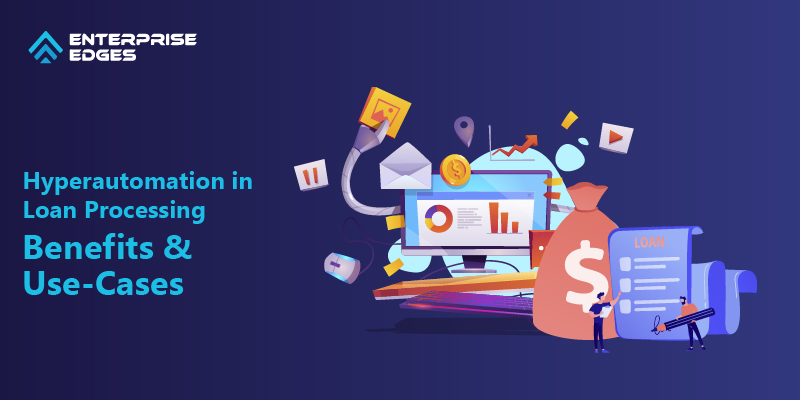Hyperautomation in loan processing is the new buzzword in the banking sector. It is revolutionizing the way banks process loans by mitigating various bottlenecks and eliminating human involvement as well.
Typically, a loan takes time to process and more time for the funds to reach the applicant. The loan origination system features intricated steps that are often subjected to human errors. This delays the processing time further. For instance, a bank needs 2-3 days to verify customer documents for mortgage loans and an average of 30 days to process them. Thankfully, hyper-automation has completely altered the system and brought relief to customers looking for urgent bank loans.
Hyperautomation in loan processing has successfully cut down loan processing time by 30%, as per reports. In addition, integrating automation into banks’ accounting systems can effectively minimize invoice processing time and cater to purchase orders with full efficiency.
Hyperautomation In Loan Processing – Use Cases
Whether personal loans or mortgages, commercial loans, or Mediclaims, these services consume much time to process. The involvement of human hands and manual handling of workflows devour so much time that getting a loan eventually seems like a blessing.
However, such bottlenecks are gradually receding, courtesy of automation. The benefits of this buzzword have been acknowledged worldwide and implemented slowly but steadily pan sectors. Banking and financial services are one of them. Lending solutions are a prime area where hyper-automation in loan processing can bring significant change.
Now, a loan goes through the following stages to get processed. Typically, the process is time-consuming and labor-intensive. The reasons being, institutions following traditional approaches to banking relied more on pen and paper than a digitalized system. Hence, the overall time taken by a loan to process is aptly justifiable.
However, the need of the hour compelled banks and financial services to look beyond the paper and pen approach and accept automation and digitalization with open arms. Hence, the moment we eliminate such bottlenecks from the system, the time devoured by each stage comes down rapidly. Let’s elucidate further with use cases to understand how important hyper-automation in loan processing is –
1. Customer Management

KYC is an integral part of every banking process and the initial stage in loan lending. The traditional physical approach to filling documents and collating customers’ personal information is lengthy and time-consuming. Even updating customer data into the system manually is subjected to human errors – calling for entry and re-entry of data. Automating loan processing can easily mitigate inconsistencies and unwanted delays in manually collecting financial data and other mandatory customer information. Application program interfaces and web-based portals facilitate easy digital onboarding of new clients and existing customer information straight into the loan origination platform of lenders. Automation of importing customer data is a huge relief from the labor-intensive administrative burden.
2. Credit Analysis

A loan can never be processed without analyzing the customer’s credit score. But, the traditional approach to credit analysis entails inputting the customer’s financial data on a spreadsheet manually and tallying them using varying formulas to add up the credit score. Contrarily, advanced loan origination software allows lenders to directly extract the relevant financial data needed for credit risk assessment from accounting software, tax returns, and other documents. Moreover, lenders can pre-screen, score the borrower, and provide an in-principle credit decision instantaneously. That spares more time for analysts to gauge the borrower’s financial risk and their capacity to repay loans. Hyperautomation of these two stages speeds up the entire loan process and benefits borrowers greatly.
3. Credit Presentation & Decisioning
Post collating customer information; the next important step is to run a complete ratio analysis, perform projected scenarios, undertake risk ratings, and then prepare the credit presentation by the risk department. Unfortunately, many lenders still follow the manual paper-pen approach, which contributes to the overall delay in loan lending. Thankfully, the hyper-automation framework eases up the hefty, manual process by automating most of the manual steps and ensuring customers get their funds in the shortest time possible.
4. Monitoring
Loan origination is not the end of the loan lending journey. Instead, it is just the beginning. The asset needs constant monitoring monthly, quarterly, or annually. Tracking data manually is not devoid of errors, especially when thousands of loan covenants are tracked on spreadsheets. This traditional approach delays loan processing indefinitely. Incorporating hyper-automation in loan processing can be a blessing for all, especially for clients and executives who have to deal with hundreds of thousands of spreadsheets filled with numbers.
5. Portfolio Risk Management
Another use case is portfolio risk management. Here, the age-old approach to loan underwriting can make lenders struggle to foresee risk exposures for each portfolio and track how those exposures change over time. Hyperautomation technologies have answers for every hurdle lenders face at different stages in the loan lending process, including assessing portfolio risks for loan receivers.
What is An Automated Loan Processor?
An automated loan processor is tasked with finding a software-based solution that assimilates the latest cloud and web technologies to automate all stages in the loan lending lifecycle.
Benefits of Automating Loan Processing

Needless to say, loan borrowers have their expectations set high from loan lenders and want speed and ease. Hence, moving away from paper-based processes to digitized and automated loan lending systems is the need of the hour. Hence, pinpointing the key benefits of hyper-automation in loan processing is paramount to guide lenders towards a new normal era of loan processing and lending. Here are the key benefits to make a note of –
1. Reliable Processing of Documents
As mentioned earlier, loan processing entails careful monitoring of borrowers’ documents and tracking and verifying information mentioned in the loan application. The information provided needs to be re-checked and matched with documents submitted by the borrower alongside the application form. Initially, the manual cross-checking of customer information consumed days and even weeks. This manual approach was subjected to unmindful errors because lenders had to juggle hundreds of different loan applications per day. But, automation has the power to speed up the entire process, reduce the excessive burden on lenders, and provide more reliable results. Hyperautomation in loan processing uses various automated tools to identically process every document simultaneously for multiple clients and generate results minus human errors.
2. A Detailed & Insightful Overview
Again, a manual checklist of paper-based documents is available only on requests on various systems. But, a comprehensive picture of the borrower’s current financial status is difficult to paint minus supportive documents and their assessed credit scores. So, sharing each file or uploading them into the system manually is again a humongous task, especially when the same task is performed simultaneously for other clients in the pipeline. Chances are high for data getting mixed up and soiled, thereby presenting an incorrect overview of the client in question.
But automating loan processing can save the day for lenders and borrowers. In a click, the automated tools can fetch a comprehensive view of all borrowers’ documents, cross-check and verify and pinpoint ones that are flagged for follow-up. Moreover, since manual tasks are eliminated, the chances of forwarding incorrect information are nearly negligible.
3. Speed & Scalability
Hyperautomation in loan processing uses intelligent content recognition tools to review and verify lenders’ documents 24 hours and 7 days a week. That cuts down loan origination time frames and quality degradation of the entire process. Moreover, reducing human involvement reduces the overhead costs associated with training lenders and other personnel. Automating the entire loan lending system can ramp up the loan processing time for each loan manifold to meet the rush of peak seasons.
4. Easy Fraud Detection
Using automation tools to review borrowers’ documents easily expose any fraudulent intention. Software programs are more adept at finding irregularities than human counterparts. Highlighting issues like addresses, names, or Social Security numbers that don’t match perfectly across dozens of documents is easy when automation is involved. Small disparities in information, which might escape the naked human eye, can easily be detected using automated tools.
Hyperautomation is the Key – Where are You Now?
Technically, all labor-intensive tasks require a touch of automation, and the banking sector has hordes of them on its plate. Loan lending is one of them. Too much involvement of human hands delays the process, which can be completed in a few hours. Hyperautomation in the loan process saves time and arrests errors that might have escaped a human eye. This approach has come as a blessing-in-guise both for lenders and borrowers. The latter can easily get their loans approved and sanctioned when they need them. For the former, automation helps them approve multiple loans simultaneously with speed and ease to meet the demands of peak seasons.
Hyperautomation is the key, not only for loan processing and lending but for other areas in banking. So, the question is – where is your company standing right now?
